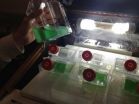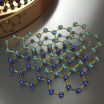(Press-News.org) VIDEO:
Land plants detect light with pigments called phytochromes, which are sensitive to red light. But red light is absorbed by water, so aquatic algae have evolved phytochromes with a much...
Click here for more information.
Aquatic algae can sense an unexpectedly wide range of color, allowing them to sense and adapt to changing light conditions in lakes and oceans. The study by researchers at UC Davis was published earlier this year in the journal Proceedings of the National Academy of Sciences.
Phytochromes are the eyes of a plant, allowing it to detect changes in the color, intensity, and quality of light so that the plant can react and adapt. "They control all aspects of a plant's life," said Professor Clark Lagarias, senior author on the study. Typically about 20 percent of a plant's genes are regulated by phytochromes, he said. Phytochromes use bilin pigments that are structurally related to chlorophyll, the molecule that plants use to harvest light and use it to turn carbon dioxide and water into food.
Lagarias' laboratory in the Department of Molecular and Cellular Biology at UC Davis studies these phytochromes and their properties. Phytochromes from land plants, Lagarias said, respond to red light — plants absorb red and reflect green light, which is why they look green. Red light does not penetrate far into water, and some marine and shore-dwelling algae lack phytochrome genes. But others do not, so Lagarias and colleagues looked at the properties of phytochromes from a variety of algae. They found that phytochromes from algae, unlike those of land plants, are able to perceive light across the visible spectrum — blue, green, yellow, orange, red and far-red.
This broad spectral coverage likely helps algae make use of whatever light they can in the ocean, Lagarias said — whether adjusting their light-harvesting chemistry for changing conditions, or rising and sinking in the water column as light levels at the surface change. Because different colors of light penetrate to different depths in water, algae face challenges in light harvesting that land plants do not. This work from the Lagarias lab shows one way that algae can rise to the occasion.
Phytochromes themselves have a long evolutionary history and likely arose from the interaction between oxygen and bilins, pigment molecules closely tied to chlorophyll and the oxygen-carrying heme pigment in hemoglobin, Lagarias said. The ancestral form appears to be sensitive to red light, similar to phytochromes of modern land plants. But between the origin and today, phytochromes went through a stage of massive diversity when they could detect a much wider range of wavelengths.
"It's a molecule that has been there and back again," Lagarias said.
The discoveries help researchers better understand the role of light and response to light in shaping ecology, as well as a model for how living cells react to light. They could also help in breeding of aquatic crops that could take advantage of different light conditions.
INFORMATION:
Coauthors on the paper are: at UC Davis, Nathan Rockwell, Deqiang Duanmu, and Shelley Martin; Alexandra Worden and Charles Bachy at the Monterey Bay Aquarium Research Institute and Canadian Institute for Advanced Research; Dana Price and Debashish Bhattacharya, Rutgers University. The work was supported by multiple agencies including the NIH, NSF, US Department of Agriculture, Department of Defense, the Packard Foundation and the Gordon and Betty Moore Foundation.
Algae 'see' a wide range of light
2014-05-01
ELSE PRESS RELEASES FROM THIS DATE:
Climate change to intensify important African weather systems, Stanford scientists say
2014-05-01
Weather systems that bring rainstorms to many drought-prone areas of northern Africa, carry Saharan dust across the ocean and seed Atlantic hurricanes could grow stronger as a result of human-caused climate change, a new analysis by Stanford scientists suggests.
Known as African easterly waves, or AEWs, these weather systems form above northern Africa during the summer season and travel east to west, toward the Atlantic Ocean.
"Not only are AEWs important for rainfall in West Africa, they also play a role in climate across the Atlantic, including here in the United ...
When it comes to classes, small is better
2014-05-01
Small classes, especially in the first four years of school, can have an important and lasting impact on student achievement, a new report shows.
In a review of over 100 papers from 1979-2014, education expert Dr David Zyngier from Monash University's Faculty of Education looked at whether the conclusions reached on the effect of smaller class sizes still hold true today.
"The question of class size continues to attract the attention of educational policymakers and researchers alike," Dr Zyngier said.
"Many argue that much of Australia's increased expenditure on education ...
Human rights report card released
2014-05-01
Real freedom, gender-based violence, terrorism laws, and asylum seekers' rights are all considered in a report released today on vital human rights issues in Australia and around the world.
The 2014 Castan Human Rights Report, by Monash University's Castan Centre for Human Rights Law, highlights the Centre's research and its relevance to some of the most important human rights issues facing society.
A key finding of the report is that freedom in Australia is being undermined.
Director of the Castan Centre Professor Sarah Joseph said the recent narrow debate on the ...
Asthma sufferers may be prone to bone loss
2014-05-01
ARLINGTON HEIGHTS, Ill. (May 1, 2014) – Some of the 26 million Americans with asthma may also be prone to bone loss. According to a study published today in the May issue of Annals of Allergy, Asthma & Immunology, the scientific journal of the American College of Allergy, Asthma and Immunology, there seems to be association between asthma and a decrease in bone mineral density.
"We know prolonged use of corticosteroids in the treatment of asthma is a risk factor of osteoporosis, but we haven't had definite data showing the relationship between asthma itself and bone loss," ...
Study: Low-fat diet helps fatigue in people with MS
2014-05-01
PORTLAND, Ore. — People with multiple sclerosis who for one year followed a plant-based diet very low in saturated fat had much less MS-related fatigue at the end of that year — and significantly less fatigue than a control group of people with MS who didn't follow the diet, according to an Oregon Health & Science University study being presented today at the American Academy of Neurology's annual meeting in Philadelphia, Pa.
The study was the first randomized-controlled trial to examine the potential benefits of the low fat diet on the management of MS. The study found ...
Tree rings reveal nightmare droughts in the West
2014-05-01
If you think the 1930s drought that caused The Dust Bowl was rough, new research looking at tree rings in the Rocky Mountains has news for you: Things can get much worse in the West.
In fact the worst drought of this century barely makes the top 10 of a study that extended Utah's climate record back to the year 1429.
With sandpaper and microscopes, Brigham Young University professor Matthew Bekker analyzed rings from drought-sensitive tree species. He found several types of scenarios that could make life uncomfortable in what is now the nation's third-fastest-growing ...
New rapid synthesis developed for bilayer graphene and high-performance transistors
2014-05-01
Researchers at University of California, Santa Barbara, in collaboration with Rice University, have recently demonstrated a rapid synthesis technique for large-area Bernal (or AB) stacked bilayer graphene films that can open up new pathways for digital electronics and transparent conductor applications.
The invention also includes the first demonstration of a bilayer graphene double-gate field-effect transistor (FET), showing record ON/OFF transistor switching ratio and carrier mobility that could drive future ultra-low power and low-cost electronics.
Graphene is ...
Australian tsunami database reveals threat to continent
2014-05-01
Australia's coastline has been struck by up to 145 possible tsunamis since prehistoric times, causing deaths previously unreported in the scientific literature, a UNSW Australia study has revealed.
The largest recorded inundation event in Australia was caused by an earthquake off Java in Indonesia on 17 July 2006, which led to a tsunami that reached up to 7.9 metres above sea level on land at Steep Point in Western Australia.
The continent was also the site of the oldest known tsunami in the world - an asteroid impact that occurred 3.47 billion years ago in what is now ...
A 'wimpy' dwarf fossil galaxy reveals new facts about early universe
2014-05-01
CAMBRIDGE, Mass. -- Out on the edge of the universe, 75,000 light years from us, a galaxy known as Segue 1 has some unusual properties: It is the faintest galaxy ever detected. It is very small, containing only about 1,000 stars. And it has a rare chemical composition, with vanishingly small amounts of metallic elements present.
Now a team of scientists, including an MIT astronomer, has analyzed that chemical composition and come away with new insights into the evolution of galaxies in the early stages of our universe — or, in this case, into a striking lack of evolution ...
China study improves understanding of disease spread
2014-05-01
LIVERPOOL, UK – 30 April 2014: Scientists at the University of Liverpool have shown how the travel and socialisation patterns of people in Southern China can give greater insight into how new diseases such as bird flu may spread between populations.
Southern China is one of the most important regions of the planet for the development and spread of new diseases in humans. In recent years a combination of high population density, frequent contact between humans and animals and the developed transport links in the region have given rise to diseases such as SARS and avian ...




